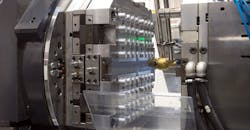The Shift to Smart Injection Molding
Injection molding is a critical manufacturing process, and has been so for a long time. It still has room to improve in several areas however, and “smart” injection molding equipment is gaining popularity as a way to address these deficiencies.
Smart injection molding introduces advanced technologies and functions like artificial intelligence (AI) and the Internet of Things (IoT) to the injection molding process. At its core, the workflow remains unchanged – but the production equipment’s ability to adapt to changing situations is improved significantly.
Setting optimal injection parameters will reduce defects in a standard injection molding operation, but not everything can be standardized. Margins for error still hover around 1.5% even after careful calibration, with these mistakes stemming from uncontrollable factors. AI may be unable to change these inevitable fluctuations, but it can detect and respond to them, mitigating their impact.
Some smart molding equipment monitors things like temperature and humidity to adapt their material heating and injection speed accordingly. Others adjust their power cycles to maintain productivity with less energy consumption. The specifics vary, but in all cases AI and IoT technologies make the process more reliable, flexible and cost effective.
Smart injection molding benefits
Embracing this trend does mean accepting higher upfront costs. Consequently, you should understand the benefits before investing in smart injection molding systems.
Accuracy and repeatability. The most noticeable benefit of smart injection molding is that it’s more accurate than conventional alternatives. Acting off of real-time data means these solutions achieve the highest precision possible. It also makes this level of accuracy repeatable over time by accounting for material and environmental inconsistencies.
Injection molding defects may be traced to many variables. Short shots alone have as many as nine probable causes, including low temperatures, insufficient pressure, and high material viscosity. IoT sensors can detect these conditions, leading AI algorithms to adjust another controllable metric to make up for it.
Such flexibility is difficult with conventional robotics. Smart solutions achieve it without sacrificing automation speed, so you no longer have to trade efficiency for quality assurance.
Energy efficiency. That same adaptability means Industry 4.0 technologies use less electricity than their predecessors. Conventional approaches waste energy through heat loss, suboptimal power cycles, and similar inefficiencies. Such missteps happen when energy use remains constant despite changing conditions – so real-time adjustments are the solution.
You can see the IoT’s efficiency benefits in familiar examples like smart thermostats. These devices run HVAC systems in response to current temperature and humidity levels instead of using a schedule or periodic readings. As a result, they use as little power as possible. Smart injection molding applies the same principle to production lines.
As you reduce molding-related energy consumption, you’ll save on utility bills. Your process also becomes more sustainable, which may be necessary under local regulations or to appeal to particular customers.
Improved maintenance. IoT and AI functionality can improve the maintenance of injection molding systems, too. The real-time data that enables operational adjustments also reveals when your equipment is not performing as it should. AI models can use these signs to predict when the machine will need repairs — a practice known as predictive maintenance (PdM).
PdM ensures that operators learn of emerging production issues as quickly as possible. Then, you can fix your injection molding equipment before anything leads to larger or more expensive breakdowns. As a bonus, planned downtime is minimized because you no longer must inspect machines manually.
Optimized maintenance can lead to 98% repair cost reductions and 95% fewer defects. Savings like this make smart molding technology worth the upfront investment.
Smart injection molding best practices
As beneficial as these solutions may be, optimal performance does not happen without a plan. You must learn to implement smart injection molding properly to experience its full potential.
First, recognize that Industry 4.0 processes require adjustment from the workforce. Higher levels of automation coincide with changing roles for employees. Such shifts can be disruptive, as nearly three in four workers lack the digital skills necessary in a tech-driven environment. Consider how smart injection molding might affect workflows, communicate these changes with your employees and offer training programs to address any newfound skills gaps.
Next, determine the best way to approach this modernization. You could replace old injection molding machines with newer, “smart” versions, or retrofit existing ones with IoT hardware. The right option depends on the current equipment’s age and condition, the price of available fixes, your throughput, and expected benefits. Calculate your potential savings and improvements from each path before deciding.
Like any other injection molding machine, smart hardware requires calibration and ongoing monitoring. Adjust the parameters for maintenance alerts and real-time adjustments according to your specific needs and OEM recommendations. Remember to benchmark your injection molding performance before and after implementation, too. That way, you can see how you’ve improved and where you may need to adjust things for a better ROI.
Changing injection molding
In a way, injection molding has remained largely unchanged over its long history. Industry 4.0 innovations bring some long-overdue improvements to the process.
Many of smart injection molding’s changes seem simple, but they carry big consequences. Recognizing this potential is the first step toward taking your manufacturing workflows into the future.
Emily Newton is the Editor-in-Chief of Revolutionized, an online magazine exploring the latest industrial innovations.
